
Horse racing is the second largest spectator sport in Great Britain, and one of the longest established, with a history dating back many centuries. According to a report by the British Horseracing Authority it generates £3.39 billion total direct and indirect expenditure in the British economy, of which £1.05 Billion is from core racing industry expenditure and the major horse racing events such as Royal Ascot and Cheltenham Festival are important dates in the British and international sporting and society calendar.
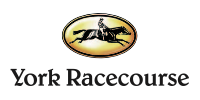
York Racecourse is a horse racing venue in York, North Yorkshire, England. It is the third biggest racecourse in Britain in terms of total prize money offered, and second behind Ascot in prize money offered per meeting. It attracts around 350,000 racegoers per year and stages three of the UK's 36 annual Group 1 races – the Juddmonte International Stakes, the Nunthorpe Stakes and the Yorkshire Oaks.

Nottingham Racecourse is a thoroughbred horse racing venue located in Nottingham, Nottinghamshire, England. It is situated at Colwick Park, close to the River Trent and about 3 km east of the city centre.
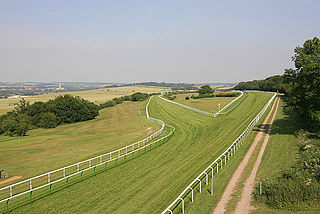
Salisbury Racecourse is a flat racecourse in the United Kingdom featuring thoroughbred horse racing, 3 miles (5 km) southwest of Salisbury, Wiltshire, England. Fifteen race meetings a year are held there between early May and mid-October.
Ian Balding is a retired British horse trainer. He is the son of the polo player and racehorse trainer Gerald Matthews Balding and the younger brother of trainer Toby Balding. Ian Balding was born in the US, but his family returned to the UK in 1945. He was educated at Marlborough College and Millfield school in Somerset. He went up to Christ's College, Cambridge, in 1959 to read Rural Estate Management, where he played Rugby for the university team, gaining his Blue in 1961 at full back. He started training in 1964. Kingsclere became his home at the age of 26 and it is here that earned his reputation as an internationally respected trainer.
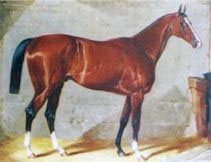
St. Gatien was a British Thoroughbred racehorse and sire. In 1884 he was involved in the second and final dead heat in the history of The Derby, part of an unbeaten sequence of twelve races. St. Gatien went on to become a dominant performer in long-distance races, winning the Gold Cup and the Alexandra Plate at Royal Ascot, the Cesarewitch Handicap carrying a record weight, and three successive running of the Jockey Club Cup.
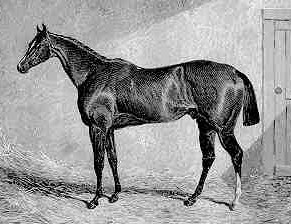
Spaniel (1828–1833) was a British Thoroughbred racehorse. In a career that lasted from July 1830 to early 1833 he ran eighteen times and won nine races. After an unsuccessful season as a two-year-old he made significant improvement in 1831 to win his first three races, culminating in The Derby. Spaniel failed to win again for over a year but then recovered to win five races on Welsh racecourses in 1832. He died after being injured on his first start as a five-year-old in 1833.
Ditto (1800–1821) was a British Thoroughbred racehorse and sire. During a racing career that lasted from May 1803 to April 1807 he was lightly campaigned, running six times in five seasons and winning four races. In the summer of 1803 he proved himself one of the best British colts of his generation, by winning Derby on his only appearance on the season. He went on to win two important races at Newmarket and a King's Plate at Guildford. Ditto was retired to stud in 1808 and had some success as a sire of winners.
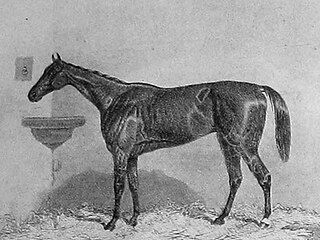
Virago (1851–1869) was a British Thoroughbred racehorse and broodmare. In a career which lasted from November 1853 to July 1855 she ran sixteen times and won eleven races. All but one of her victories came as a three-year-old in 1854, a year in which she dominated British racing, winning major events at distances ranging from one mile to three miles. Her wins included the classic 1000 Guineas at Newmarket, the Nassau Stakes and the Yorkshire Oaks against her own age and sex. More notable were her successes in open competition, including the Goodwood and Doncaster Cups and three of the season's most valuable handicap races. She was regarded by many British experts as one of the greatest racehorses of the 19th century.

Grey Momus was a British Thoroughbred racehorse and sire. In a career that lasted from August 1837 to 1839 he competed twenty-one times and won fourteen races. Grey Momus first attracted attention as a two-year-old when he recorded two impressive victories at Goodwood in August. In the following year he won seven times from nine starts, taking two of the year's biggest races, the 2000 Guineas at Newmarket and the Gold Cup at Ascot. Grey Momus won one competitive race and took three walkovers in 1839 before being retired. He was exported to stand as a stallion in Germany, where he had some success as a sire of winners.
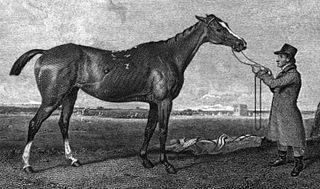
Rhoda was a British Thoroughbred racehorse and broodmare who won the third running of the classic 1000 Guineas at Newmarket Racecourse in 1816 and was the most successful racehorse in Britain two years later. Rhoda was one of the most active of all British classic winners, running in at least forty-five contests between 1816 and 1820 and winning twenty-one times. Her actual number of competitive races was even higher as many of her later races were run in multiple heats, with the prize going to the first horse to win twice. She won the 1000 Guineas on her second appearance but did not run as a three-year-old after finishing unplaced in the Oaks Stakes. Rhoda won three races in 1817, ten in 1818, four in 1819 and two in 1820.
Young Mouse (1826–1843) was a British Thoroughbred racehorse and broodmare who won the sixteenth running of the classic 1000 Guineas at Newmarket Racecourse in 1829. In a racing career which lasted from May 1829 until July 1830 the filly ran six times and won three races. Young Mouse won the 1000 Guineas on her first competitive appearance and then ran unplaced in the Oaks Stakes before winning two match races at Newmarket in autumn. She was retired from racing after a single, unsuccessful run as a four-year-old. Young Mouse was later exported to France where she had some success as a broodmare.
Galantine was a British Thoroughbred racehorse and broodmare who won the eighteenth running of the classic 1000 Guineas at Newmarket Racecourse in 1831. Running exclusively at Newmarket, the filly ran eleven times and won four races in a racing career which lasted from April 1830 until May 1831. After being beaten in both her races as a two-year-old, Galantine won a controversial race for the 1000 Guineas on her three-year-old debut, beating the odds-on favourite Oxygen. Although she was considered a lucky and sub-standard classic winner, Galantine went on to win three match races at before the end of the season. She was retired from racing after two unsuccessful runs in 1832.
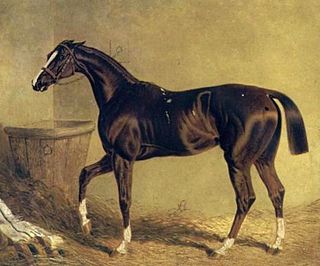
Camarine was a British Thoroughbred racehorse and broodmare. After finishing second on her only start as a two-year-old, Camarine was undefeated for the next three years, winning thirteen consecutive races at distances ranging from five furlongs to two and a half miles. Her dominance over her contemporaries was compared to that of Eclipse sixty years earlier.

Meteora (1802–1821) was a British Thoroughbred racehorse and broodmare who won the classic Oaks Stakes at Epsom Downs Racecourse in 1805. In a racing career which began with her win in the Oaks on 31 May 1805 and lasted until July 1810 she ran thirty-six timeas and won twenty-four races. She defeated the Derby winner Cardinal Beaufort and the St Leger winner Staveley in match races and won many other important races of the era including the Stamford Gold Cup, the Oatlands Stakes (twice), the Audley End Stakes, the Somerset Stakes and the Brighton Gold Cup. Many of her defeats occurred when she was carrying large weights in handicap races.
Sorcery was a British Thoroughbred racehorse and broodmare who won the classic Oaks Stakes at Epsom Downs Racecourse in 1811. In a racing career which lasted from April 1811 to July 1814 the filly ran twenty-six times, winning twelve races and finishing placed on eleven occasions. Sorcery won the Oaks on her third racecourse appearance and went on to win other important races including the Epsom Gold Cup, the Trial Stakes, two editions of the Oatlands Stakes, a King's Plate and several match races. After her retirement from racing she became a successful broodmare, being the dam of the 1828 Epsom Derby winner Cadland.

Vespa was a British Thoroughbred racehorse and broodmare who won the classic Oaks Stakes at Epsom Downs Racecourse in 1833. The filly's win at Epsom, a 50/1 upset, was the only success in her first two seasons of racing. She produced her best form as a four-year-old when she won four times, including three important races at Newmarket Racecourse. At the end of her British racing career she was sold and exported to Hungary.
Squirrel was a British Thoroughbred racehorse. He won seven of his nine races, including the 1400 Guineas Stakes and match races against Dapper and Jason. He was also a successful stallion, siring Craven Stakes winner Firetail. However he was more well known for producing broodmares, siring the dams of seven Classic winners including Derby winner Noble, along with the dam of champion sire Trumpator. Squirrel was owned by Jenison Shafto.
Petronel was a British Thoroughbred racehorse and sire. After showing promise when winning the Troy Stakes as a juvenile in 1879, he recorded a major upset when defeating his more fancied opponents to take the 2000 Guineas in the following spring. He had never been entered in the other British Classic Races, but won at Royal Ascot and in several other top-class races that year. In 1881 he was one of the best staying horses in England, winning seven races including the Epsom Stakes, Rous Memorial Stakes, Great Yorkshire Handicap and Doncaster Cup as well as Queen's Plates at Stockbridge, Newmarket and Liverpool. He developed breathing problems and was never as good again, although he won Queen's Plates at Stockbridge and Newcastle in 1882. After his retirement from racing he had some success as a breeding stallion.
Reve d'Or was a British Thoroughbred racehorse and broodmare who won two British Classic Races in 1887. She ran nine times as a juvenile in 1886, winning three races including an upset victory in the Dewhurst Plate in October. In the following year she won nine races including the 1000 Guineas, Oaks Stakes, Sussex Stakes, York Queen's Plate, Yorkshire Oaks, Great Foal Stakes and Newmarket Oaks. She remained in training until the age of seven, winning the Jockey Club Cup in 1888 and the City and Suburban Handicap in 1890. She had limited success as a broodmare in France.

















